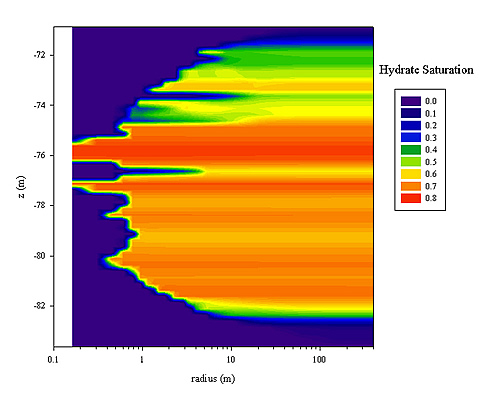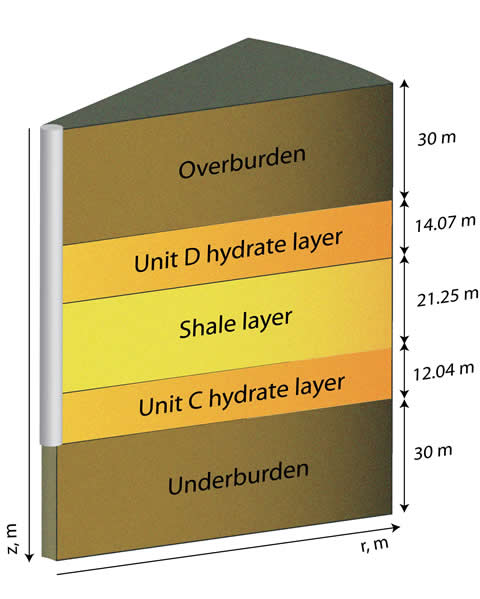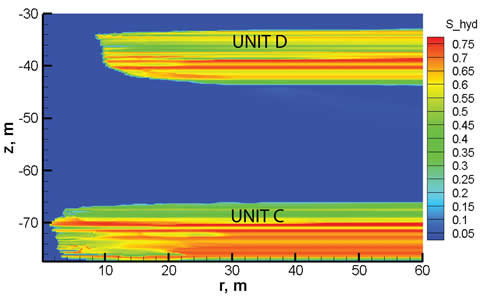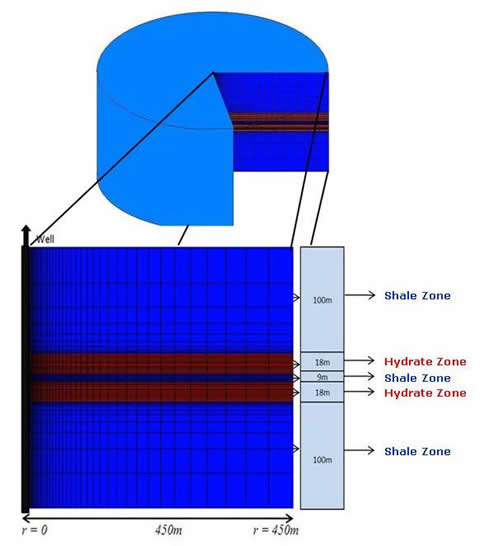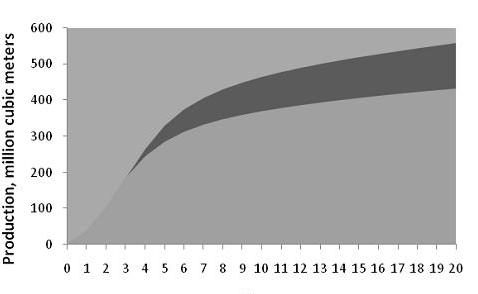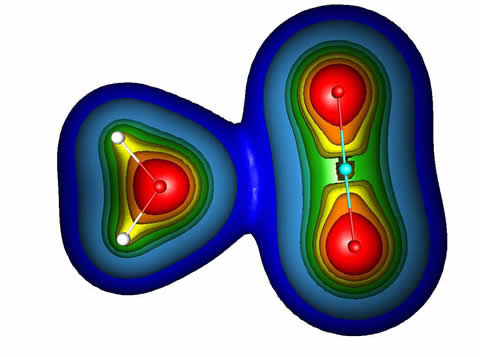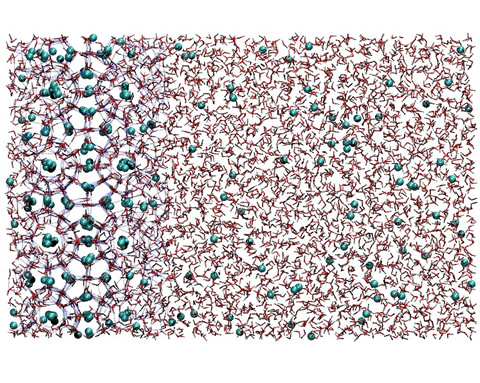In addition to the information provided here, a full listing of project related publications and presentations as well as a listing of funded students can be found in the Methane Hydrate Program Bibliography [PDF].
Quarterly Research Progress Report [PDF-3.46MB] April - June, 2015
Quarterly Research Progress Report [PDF-2.77MB] January - March, 2015
Quarterly Research Progress Report [PDF-1.31MB] October - December, 2014
Quarterly Research Progress Report [PDF-3.01MB] July - September, 2014
Quarterly Research Progress Report [PDF-2.40MB] April - June, 2014
Quarterly Research Progress Report [PDF-2.62MB] January - March, 2014
Peer-Reviewed Publications
Anderson, B., Hancock, S., Wilson, S., Enger, C., Collett, T., Boswell, R., Hunter, R., 2010. “Formation pressure testing at the Mount Elbert Gas Hydrate Stratigraphic Test Well, Alaska North Slope: Operational summary, history matching, and interpretations,” Marine and Petroleum Geology, Vol. 28, Iss. 2, Thematic Set on Scientific results of the Mount Elbert Gas Hydrate Stratigraphic Test Well, Alaska North Slope, Pages 478-492, ISSN 0264-8172, doi: 10.1016/j.marpetgeo.2010.02.012.
Anderson, B.J., Kurhiara, M., Wilson, S.J., Pooladi-Darvish, M., White, M., Moridis, G., r Gaddipati, M., Masuda, Y., Collett, T.S., Hunter, R.B., Narita, H., Rose, K., Boswell, R., 2010. “Regional long-term production modeling from a single well test, Mount Elbert Gas Hydrate Stratigraphic Test Well, Alaska North Slope,” Marine and Petroleum Geology, Vol. 28, Iss. 2, Thematic Set on Scientific results of the Mount Elbert Gas Hydrate Stratigraphic Test Well, Alaska North Slope, Pages 493-501, ISSN 0264-8172, doi: 10.1016/j.marpetgeo.2010.01.015.
Gamwo, I.K., Liu, Y, 2010. “Mathematical Modeling and Numerical Simulation of Methane Production in a Hydrate Reservoir,” Industrial Engineering & Chemical Research, 49 (11), pp 5231–5245.
Hunter, R.B., Collett, T.S., Boswell, R., Anderson, B.J., Digert, S.A., Pospisil, G., Baker, R., Weeks, M., 2010. “Mount Elbert Gas Hydrate Stratigraphic Test Well, Alaska North Slope: Overview of scientific and technical program,” Marine and Petroleum Geology, Vol. 28, Iss. 2, Thematic Set on Scientific results of the Mount Elbert Gas Hydrate Stratigraphic Test Well, Alaska North Slope, Pages 295-310, ISSN 0264-8172, doi: 10.1016/j.marpetgeo.2010.02.015.
Wilson, S.J., Hunter, R.B., Collett, T.S., Hancock, S., Boswell, R., Anderson, B.J., 2010. “Alaska North Slope regional gas hydrate production modeling forecasts,” Marine and Petroleum Geology, Vol. 28, Iss. 2, Thematic Set on Scientific results of the Mount Elbert Gas Hydrate Stratigraphic Test Well, Alaska North Slope, Pages 460-477, ISSN 0264-8172, doi: 10.1016/j.marpetgeo.2010.03.007.
Other Publications
Boswell, R., T. Collett, B. Anderson, and C. Ruppel, 2010. “Relative gas volumes for free gas and gas hydrate accumulations.” U.S. DOE-NETL Fire in the Ice Newsletter, Summer 2010. pp. 9-11.
Presentations
Anderson, B., 2010. “Models of gas hydrates from the cage to the reservoir: insights from modeling at many scales,” Gordon Research Conference on Natural Gas Hydrate Systems, Colby College, Waterville, ME, June 6-11, 2010.
Anderson, B.J., “The Role of Molecular Level Modeling in Gas Hydrate Studies,” Centre Europée de Calcul Atomique et Moléculaire/Atlantic Centre for Atomistic Modelling, Dublin, Ireland, May 6-8, 2010.
Anderson, B.J., “Hydrate Reservoir Simulator Code Comparison Project: 7 problems from simple 1-D to complex 2-D simulations,” WV Regional Society of Petroleum Engineers Meeting, Morgantown, WV, April 21, 2010.
Anderson, B.J., “Multiscale Modeling: Molecular, Thermodynamic, Reservoir, and Economic Modeling of Energy Systems,” West Virginia Academy of Science 85th Annual Meeting, Morgantown, WV , April 10, 2010.
Anderson, B.J., “The Role of Molecular Level Modeling in Gas Hydrate Studies,” AIChE Annual Meeting, Nashville, TN, November, 2009.
Gaddipati, M., Anderson, B.J., 2010. “Methane production from complex gas hydrate reservoirs: Effects of reservoir heterogeneity on gas production,” West Virginia Academy of Science 85th Annual Meeting, Morgantown, WV , April 10, 2010.
Garapati, N., Anderson, B.J., “Predictions of Phase Equilibrium Data of Mixed Hydrates Using the Cell Potential Method,” West Virginia Academy of Science 85th Annual Meeting, Morgantown, WV, April 10, 2010.
Garapati, N., Anderson, B.J., “Predictions of Mixed Hydrate Phase Equilibria and the Swapping of CH4 Hydrate with CO2 and CO2+N2 Mixtures,” AIChE Annual Meeting, Nashville, TN, November, 2009.
Myshakin, E. M., Anderson, B. J., Rose, K., Boswell, R., 2010. "Simulation of long-term depressurization-induced gas production from C & D unit reservoirs, Mount Elbert-01, Milne Point Unit, North Slope Alaska, Hydrate Deposit," National Gas Hydrates Research and Development Program Review, Georgia Institute of Technology, Atlanta, GA, January, 2010.
Myshakin, E. M., Gamwo, I. K., Warzinski, R. R., 2009. “Experimental Design Applied to Simulation of Gas Productivity Performance at Reservoir and Laboratory Scales Utilizing Factorial ANOVA Methodology,” TOUGH Symposium, Berkeley, CA.
Velaga, S., Anderson, B.J., 2010. "Calculation of N2 hydrate reference parameters and cell potential parameters to analyze the N2-CO2 and N2-CH4 three-phase equilibrium and structural transitions", West Virginia Academy of Science 85th Annual Meeting, Morgantown, WV, April 10, 2010.




